This is an Ihagee Auto-Ultrix type 2850, an auto-erecting folding camera made by Ihagee Kamerawerk, Steenbergen & Co. Dresden between the years 1932 and 1939. The Auto-Ultrix family had many variants, but the type 2850 produced eight 4cm x 6.5cm images on 127 format roll film. This particular example was a well equipped model, coming with the top of the line combination of a Zeiss Tessar 7cm f/3.5 lens and Compur shutter. It had a flip up reverse Galilean viewfinder and a helical mount, which was an upgrade from the lesser type 4850 which had front cell focus and a wire frame finder.
Film Type: 127 Roll Film (eight 4cm x 6.5cm exposures per roll)
Lens: 7cm f/3.5 Carl Zeiss Jena Tessar uncoated 4-elements
Focus: 4 feet to Infinity (Helical)
Viewfinder: Flip-Up Reverse Galilean Scale Focus
Shutter: Compur Leaf
Speeds: T, B, 1 – 1/300 seconds
Exposure Meter: None
Battery: None
Flash Mount: None
Weight: 308 grams
Manual (similar model): http://www.cameramanuals.org/pdf_files/ihagg_auto-ultrix.pdf
Catalog (in German): http://www.ihagee.org/IPD/IPD2-autoultrix2~1933.pdf
How these ratings work |
The Ihagee Auto-Ultrix 2850 was a compact and very well made German folding camera that used “Vest Pocket” film and took 4cm x 6.5cm images on 127 foll film. It was available with a variety of shutter and lens combinations, and the example here was the top of the line model. In good working condition, this camera is an extremely capable shooter, producing images more than 3 times larger than that of 35mm film in a body that was nearly the same size. It’s an uncommon camera to come across, but when found in good working condition is an excellent addition to any collection. | ||||||
| Images | Handling | Features | Viewfinder | Feel & Beauty | History | Age | |
| 2 | 2 | 1 | 1 | 2 | 1 | 40% | |
| Bonus | none | ||||||
| Final Score | 12.6 | ||||||
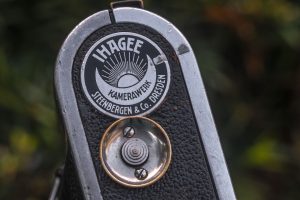
History
Throughout the 20th century, there have been no less than 21 camera manufacturers based out of Dresden, Germany, and another 4 more if you count nearby Freital, which begs the question, why are there so many companies all in the same area working on camera manufacturing? Perhaps there is something in the water, or Dresden’s long history as capital city of Saxony. Perhaps Dresdenites just really, really like taking pictures of stuff. I’ve never found a reason why so many different companies were clustered in such a small area, but nevertheless, you cannot even begin to start collecting old cameras without running into at least half a dozen Dresden based cameras right off the bat.
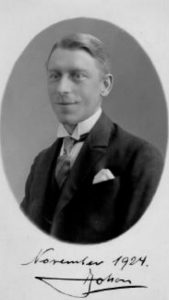
Ihagee was founded in 1912 by a Dutchman named Johan Steenbergen as Industrie-und Handelsgesellschaft which stands for Industry and Trade Society. Often referred to by the nickname IHG, the company name was eventually shortened to Ihagee Kamerawerk since Ihagee is pronounced the same in German as saying “I H G”. In recent years, Ihagee is often misspelled as Jhagee, as the script often used to stylize the logo, gives the “I” a curl, like the letter “J”.
In the early years, Ihagee produced a variety of plate and roll film cameras, but many were sold as “white label” designs for other manufacturers or distributors. This article mentions models sold under the names Photorex and Coronoa, but then that same article goes on to say that many of these early Ihagee cameras were not labeled with a name. Perhaps the lack of any identifying name is why it is difficult to find any conclusive information about early Ihagee models.
One exception to this were the company’s Ultrix lineup of cameras. Like most folding camera lines of the early 20th century, the Ultrix was available in a variety of sizes and designs, and came with a large number of shutter and lens combinations.
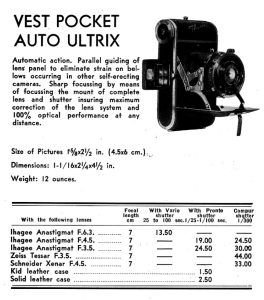
Most Ultrix models were given the name “Auto” Ultrix in which the use of the word “auto” referred to the design of the body, where upon folding down the front plate of the camera automatically extended the lens and shutter to the shooting position. Earlier folding designs were of the “folding bed” design in which opening the camera and extending the bellows was a two step process.
Ihagee Ultrixes were sold in roll film formats from 6cm x 9cm all the way up to 8cm x 14cm formats, and some even supported sheet film or glass plates.
The smallest Ultrix however, was a separate model called the “Westentaschen” or “Vest Pocket” Auto Ultrix. A very compact model, the Vest Pocket Ultrix shot eight 4cm x 6.5cm images on 127 format or “Vest Pocket” film. The Vest Pocket cameras were given the model numbers 2850 and 4850, the latter being a simplified model with a folding metal frame finder, and a more basic f/6.3 lens and shutter combination. In a 1933 catalog from Herbert & Huesgen Co of NY, the Vest Pocket Auto-Utrix had prices starting at $13.50 all the way to $44 for the top of the line model. When adjusted for inflation, these prices are comparable to $260 to $850 today.
The German language catalog below is courtesy of ihagee.org and dates to approximately 1932. I don’t speak German, but the images and the charts give a general idea of the variations that were available.
Ihagee’s Ultrix series was it’s most popular lineup until 1933 when it would release it’s first “miniature” Single Lens Reflex camera which they called the Exakta. This first Exakta SLR took 4.5cm x 6cm images on 127 roll film just like the Vest Pocket Ultrix. In 1936, Ihagee would revise the Exakta for Kodak’s new 135 format 35mm film, and gave it the name Kine Exakta. The word “Kine” was short for the word “cine” or “cinema”, and never appeared on the camera itself, but was used in literature to differentiate the 35mm film version from the original 127 roll film Exakta.
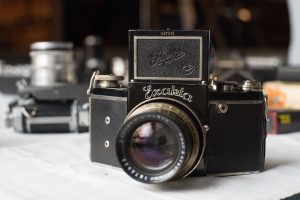
The Exakta would go on to become one of the most successful camera lines of all time, and for the next several decades, Ihagee’s only camera line. Exaktas were the camera of choice for professionals throughout the 1940s and 50s until the Japanese took over with models from Asahi (Pentax), Orion (Miranda), and eventually Nippon Kogaku (Nikon). Even after their prominence fell by the wayside, the Exakta’s little brother, the Exa, continued to be produced until the late 1980s.
Today, most prewar German made folding cameras are grouped together into a large sub-category of “nickel and leather” cameras and are highly collectible. Whether it’s an Ihagee Auto-Ultrix, or models made by Nagel (Kodak), Certo, Zeiss-Ikon, Voigtländer, Wirgin, Zeh, or any other number of early 20th century German companies, these are all great cameras. They were well made, and assuming they were stored properly over the years, are usually still in good working order today. The Vest Pocket Auto-Ultrix is not an easy camera to find on the used market, but there are a huge number of other ones that are comparable and equally as deserving to belong in your collection!
My Thoughts
From time to time, readers of this site will contact me and ask if I would be interested in repairing their cameras. I almost always say no. I don’t say no because I don’t want to help them, but I would feel an obligation of making sure the camera is perfect before sending it back, and my track record of getting my own cameras into a perfect operating condition isn’t that great. I’d say my ratios are close to 67% for some functionality and maybe 40% for most functionality.

On occasion I do make exceptions, and the story of this Ihagee Auto-Ultrix is one of those exceptions. Reader and fellow Vintage Camera Collector member, Dan Arnold had made a post about a new (to him) Ultrix that he had picked up which was in outstanding cosmetic condition, but the shutter was sluggish. Dan asked for advice on who he could send it to for repair, and I offered to give it a shot. My payment would merely be to keep the camera long enough to shoot some film in it and give it a review.
Upon it’s arrival, I could see why Dan wanted this camera to be repaired as it was in immaculate shape. While it’s not unusual for any 1930s camera to have a sluggish or stuck shutter, my guess is that the combined effects of time and very little use contributed to this camera’s demise. As I had theorized, a quick soak in naphtha should be all that the 80+ year old Compur shutter needed, and I was right. I removed the shutter from the camera, soaked it, and let it dry overnight, and upon adding a couple very tiny spots of lithium grease to certain areas of the shutter, I had it back in great working condition.
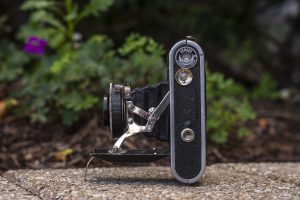
The word “auto” in the camera’s name, Auto-Ultrix, refers to the auto, or self-erecting design of the camera. Many folding cameras of the early 20th century, required a two step process to open the camera. First, you must release and fold down the door, or bed, of the camera, and in a second motion pull the lens and shutter assembly into a fully erect position. Self erecting cameras like the Auto Ultrix, do this for you when you open the camera. This is done by pressing an ornamental metal button on the side of the camera next to the elegant Ihagee logo. The camera won’t open fully on it’s own, so you’ll need to help it until it locks into it’s fully erect position.
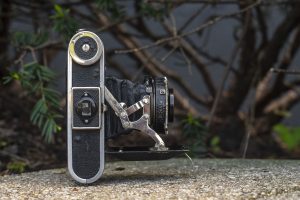
On either side of the camera, you can see the clever hinges that use multiple pivot points to accomplish the “automatic erecting” magic. This might seem rudimentary today, but this was cool stuff back then! On the side of the camera opposite of the release button and Ihagee logo is the folding 6×9 glass viewfinder. The 2850 Auto-Ultrix seen here has a reverse Galilean glass viewfinder with horizontal and vertical framing lines in it. There was also a less expensive 4850 Auto-Ultrix which lacked glass in the viewfinder and was a simple metal frame. Next to the viewfinder is the film advance knob.
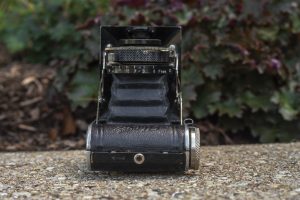
Opening the back of the camera requires sliding a door latch on the top edge of the camera. Sometimes orientation on folding cameras can be confusing, so I’ll call the “top” of the camera the side that faces upward when the camera is displayed using it’s kickstand. Also visible from this angle are distance markings on for the focusing helicoid.
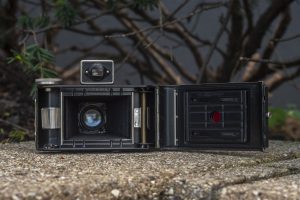
The film compartment is pretty standard fare for a 127 format roll film camera. Film travels from right to left. In the image to the left, an old 127 spool is still on the supply side of the camera. Before I could shoot it again, I would need to move this spool to the left chamber, thread the paper leader from a new roll to it, and then insert the new roll into the right chamber.

The back of the camera shows the centrally located hole for viewing the exposure numbers on the backing paper of film. The Auto-Ultrix shoots eight “full frame” 4×6.5cm images per roll, so there is no need to double up numbers like on half frame 127 cameras. Notice the bumps in the leather of the camera. These are known as “Zeiss Bumps” and are very common on early 20th century cameras with leather body coverings. They are caused by a chemical reaction between the adhesive used to hold the leather to the body, and brass fittings or rivets in the body of the camera, usually those for the film pressure plate, but they can be found elsewhere. They usually don’t harm the value of the camera, and some people actually prefer the look they give to the “patina”.
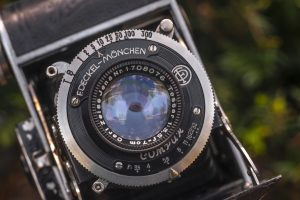
Later Ultrixes like this one come with a rim set Compur shutter like this one. Like all rim set Compurs, shutter speeds including T and B are set using the outer ring around the shutter, with the aperture set using a small lever on the bottom of the shutter. Near the 10 o’clock position is an arm for cocking the shutter, near the 2 o’clock position is the focus arm, and near the 7 o’clock position is the shutter release.
I have a variety of pre-war 127 film cameras including the Kodak Vollenda 48, Foth Derby, and others, but the Ihagee Auto-Ultrix was so well designed, and so beautiful, that I wanted to keep shooting it. The Auto-Ultrix is simply a fantastic camera, and I both cursed and thanked Dan for letting me borrow it as it was tough to send it back.
My Results
For the first roll through the Auto-Ultrix I chose a fresh-ish roll of Rerapan 100. I say “fresh-ish” as it was fresh when I got it, but it’s sat in my drawer for about 2 years before finally coming around to it. I doubt the film lost any speed in the 2 years since I’ve had it, so I shot it like a normal 100 speed film figuring the film’s latitude could handle any error in exposure I threw at it.
My first experience with Rerapan was with the Bell & Howell Electric Eye 127 which delivered over exposed and extremely contrasty images with very poor shadow detail and blown out high lights. I soured to Rerapan, thinking it to be an inferior film. In the years since shooting that camera, I’ve not only grown as a photographer, but also develop my own film, and I’ve learned that black and white film is greatly affected by how you develop it. Most commercial labs simply give average settings with most black and white films so as to get “an image” without catering to the film’s strengths.

With many rolls of black and white film developed at home using HC-110, the images I can get from Rerapan are leaps and bounds better than those original images. With my improved ability to develop my own black and white film, the Auto-Ultrix delivered in a big way.
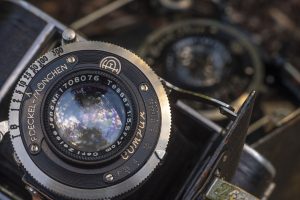
The 7cm uncoated Tessar lens is obviously the gem here, but I’ve seen much worse results from other Tessars as I believe the quality of an image is not entirely dependent on it’s lens. If a camera is poorly setup, or difficult to use, it can be much harder to get good shots, and as you can see from the gallery above every single image came out great. I think this might be the first review on this site where I shared every image from the entire roll. Usually I leave out some images due to something being wrong with the image, or a duplicate of another I took. But not here. Above are all eight images from that first roll through the camera, including a really rare photo of me, shot by my wife!

Further adding to the visual appeal of these images is the larger 127 film format. Making images that are 40mm x 65mm, each image has 3 times the surface area (2600 mm² vs 864mm²) of a full frame 35mm negative, yet comparing the size of the Auto-Ultrix to a period correct 35mm Kodak Retina, the two cameras are nearly identical in size. In the image to the right, take a look at the scanned negative from the Auto-Ultrix, compared to that from a 35mm camera.
If you’ve ever used a German folding roll film camera before, everything about using the Ultrix is like those, but smaller. For anyone whose never shot a camera like this, it’s really quite easy. When I first started collecting cameras, I thought that I would stick to familiar 35mm cameras because everything else was too intimidating, but in reality, cameras like the Auto-Ultrix were created with novices in mind. With a few minutes reading reviews like mine and the user manual, and a little bit of patience, anyone today can shoot a camera like this. The film isn’t as widely available as it used to be, with with quality stocks like Rerapan, and other hand rolled options, if you have the desire to shoot a camera like this (and you should) I wholeheartedly recommend trying it!
Related Posts You Might Enjoy
External Links
http://camera-wiki.org/wiki/Ultrix
http://quirkyguywithacamera.blogspot.com/2017/05/the-127-auto-ultimate-ihagees-auto.html
https://connealy.blogspot.com/2017/10/ihagee-auto-ultrix-127.html

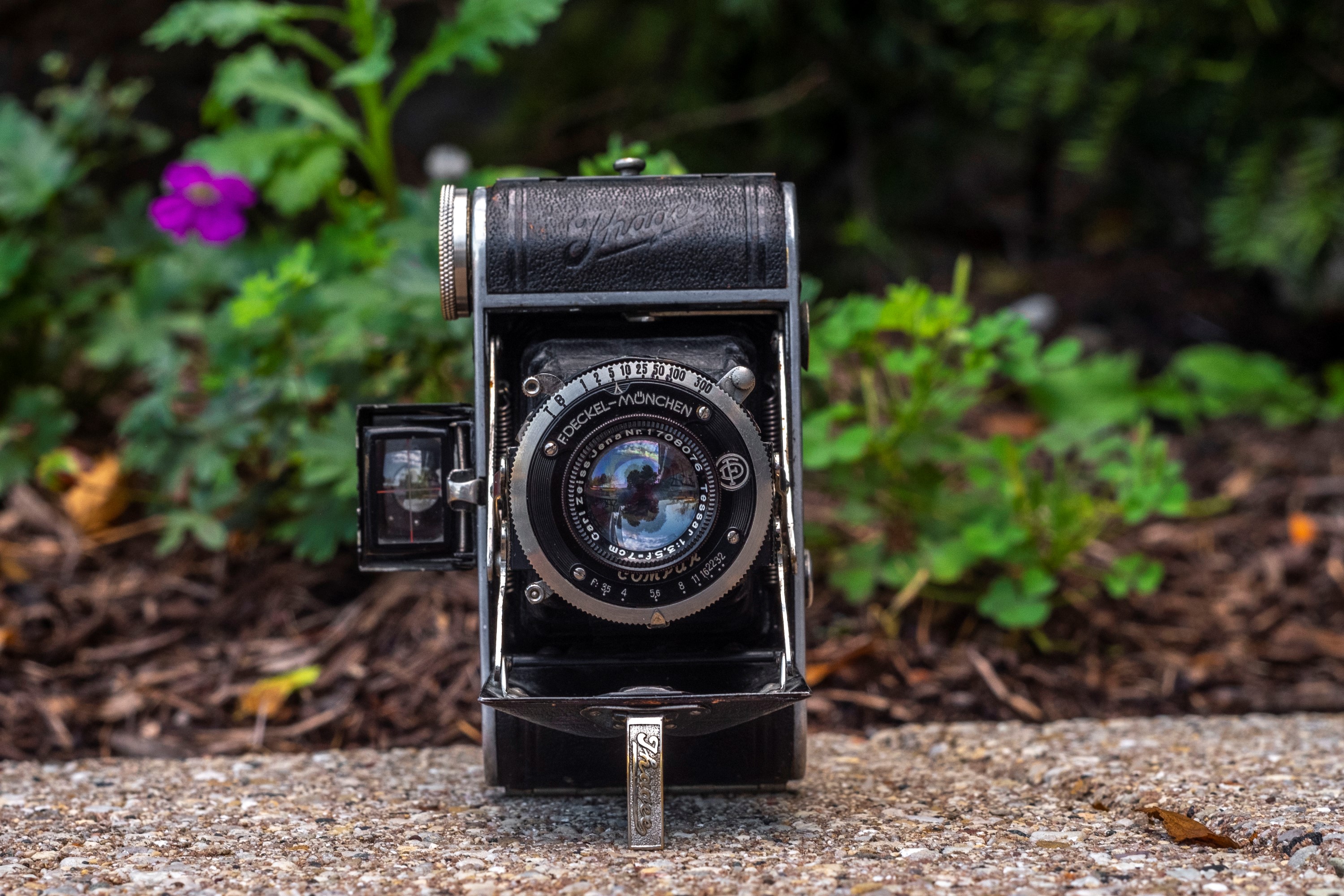

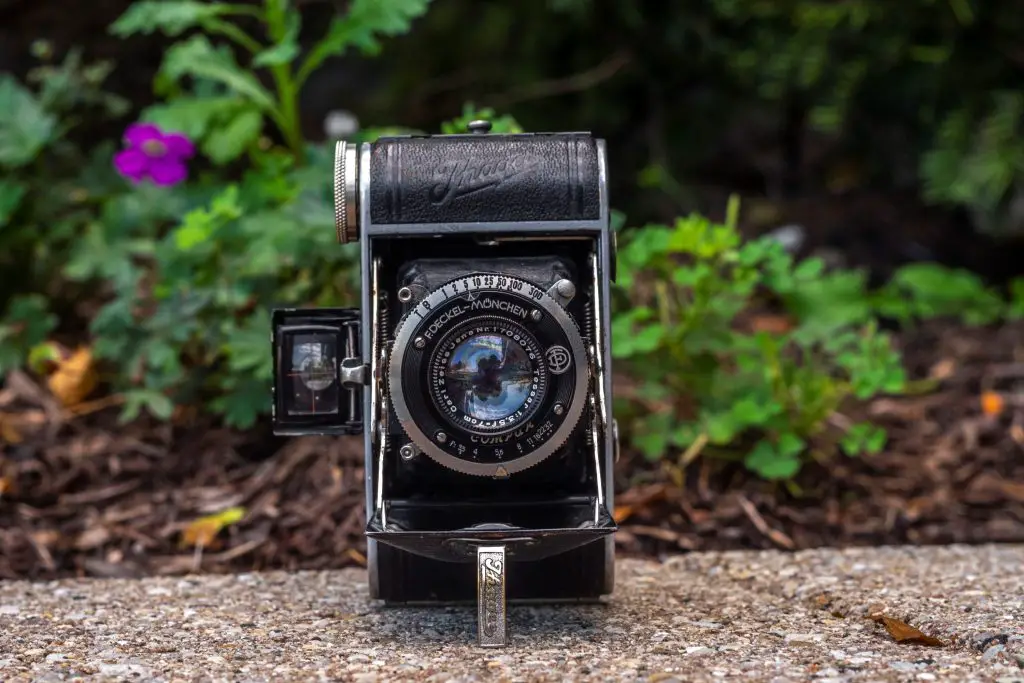














Decades of collecting Ihagee products provoke this observation: Beware the 6×9 Ultrix cameras (which use more readily available 120 rollfilm), as they are not particularly well-made. The bodies are stamped from thin aluminum, and both the film and lens doors are prone to flexing. The results can be fogged film and images that are not sharp corner-to-corner (as the lens standard loses proper alignment with the film plane).
.
If you want to shoot with a truly well-made Ihagee 127 rollfilm camera, look for a Parvola. These are 3×4 shooters with lens and shutter mounted on a helical similar to the original 6×9 VP Exaktas. Several lens/shutter combos exist, most frequently a house-branded 50mm f3.5 lens, or a Tessar f2.8. The real gem (if you can land one under $400) has a Schneider Xenar f2.0 in a Compur-Rapid rimset.
.
You might also find 4×6.5 format Parvolas, the same basic design scaled up for 120 rollfilm, and usually fitted with a 75mm Tessar. Regardless of format and film size, these are very nicely-finished 1930s cameras built from stout materials.
That’s good to know about the 6×9 Ultrixes. I can tell you without a shadow of a doubt, that whatever cheapness is in the larger cameras, is not there for the 2850s. This is a very well built camera, every bit on par with the quality of a Nagel or Zeiss folder of the same era.
And its interesting you recommend the Parvola, as Dan, the guy who loaned me this camera has one of those too and has offered to send it my way. I’ll likely take him up on his offer, but after getting caught up on some other reviews I’m working on.